Index

Review: Win XP 32-bit vs Win7 64-bit
This review is also available in German.
While Sanjin was busy checking out the performance of the new GTX 480 in Windows 7, some people like me were more interested in the performance differences between Windows XP in DX9 and Windows 7 with DX10/ DX11. Of course power consumption is also very important, especially in Europe where energy prices are high. One of the problems between AMD and Nvidia is the impossibility to compare higher Anti-Aliasing modes, because only Multi-Sampling between 2x and 8x are comparable and we have to stick with it.
Testbed:
Motherboard:
MSI P55-GD65 (provided by MSI)
Intel P55
CPU:
Intel Core i5 750 (provided by Intel) overclocked to 4.00GHz
CPU-Cooler:
Scythe Grand Kama Cross (provided by Scythe)
Memory:
G.Skill 4GB Kit PC3-12800 (provided by G.Skill)
1600MHz CL8-8-8-24 CR1T 1.40V
Graphics Cards:
MSI R4850-2D1G-OC (provided by MSI)
XFX Radeon HD5850 1GB (provided by XFX)
Nvidia GTX480 (provided by Nvidia)
Power supply:
OCZ Fatal1ty 700W (provided by OCZ)
Hard disk:
Samsung F1 1000GB RAID-Edition (provided by Ditech)
Case:
Cooler Master Stacker 831 Lite (provided by Cooler Master)
OS:
Windows XP SP3, updates March 31st, 2010
HD4850/HD5850: AMD ATI Catalyst 10.3
GTX480: Nvidia 197.15
Windows 7 64bit, updates April 6th, 2010
HD4850/HD580: AMD ATI Catalyst 10.3b
GTX480: Nvidia 197.25
3DMark
All the benches were run with AF 8x and AA 8x, except for 2006 with HD 4850 where we could not enable AA. Naturally, Windows 7 runs the benches in 32bit, and this has an impact on the performance especially CPU-Score. Sorry, I could not be bothered to use Vantage.
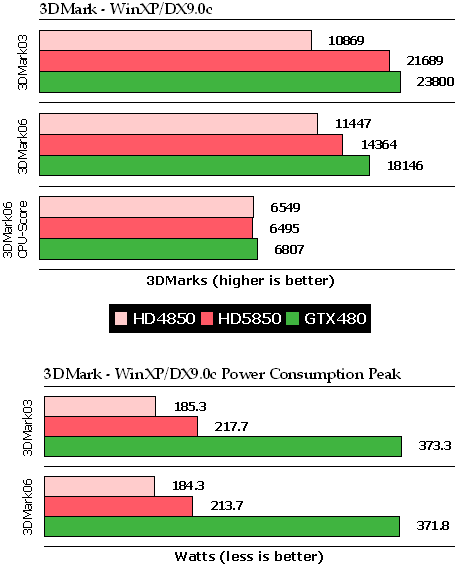
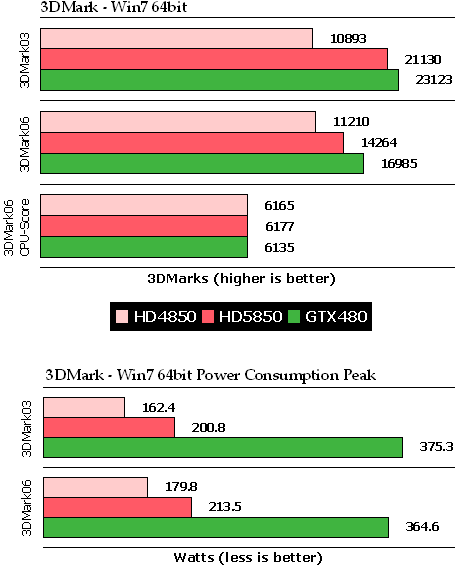
FarCry 2
Because the HD4850 is not a high-end card, we limited AA to 4x and to "very high" settings. HD 5850 and GTX480 run with "ultra settings" and AA 8x. The game has its own AF modes which cannot be changed. Resolution is 1080p (1920x1080). As usual the Game has only a 32-bit exe, which is not great and it slows down performance in Windows 7 but in this case the game runs faster with DX10.
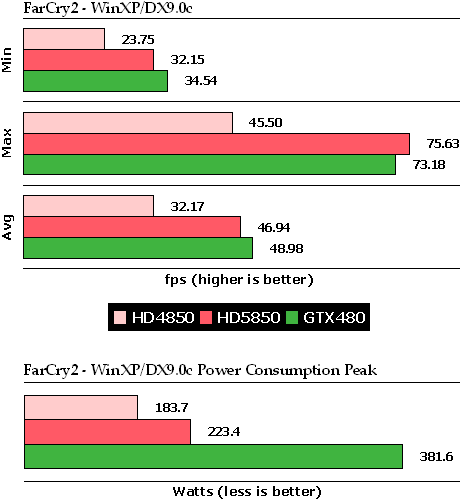
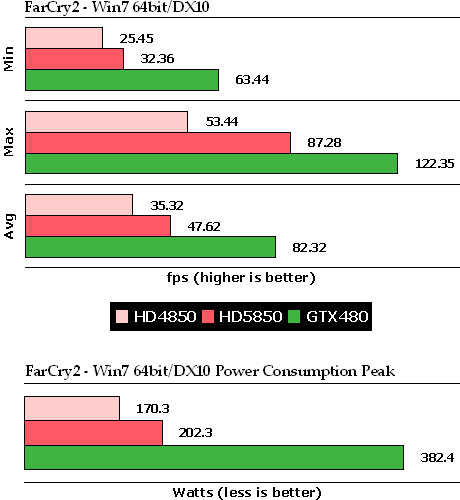
Stalker: Call of Pripyat
The HD4850 ran at high settings including HDAO high, whereas the HD5850 and GTX480 ran with extreme settings, HDAO CS or PS. All the benches were performed at 1080p resolution without AA. Unfortunately, DX10/DX11 only slows performance down and the eye-candy is not worth it. Interestingly the GTX480 drew about twice the power under Windows XP and DX9, despite the fact that performance did not get the same “boost”. It's worth noting that the GTX 480 is rather pointless in an XP environment, so it is understandable Nvidia did not waste resources on optimizing its drivers for this ancient, but still widespread OS. In Windows 7, the HD5850 leads the performance charts, but is able to save some Watts.
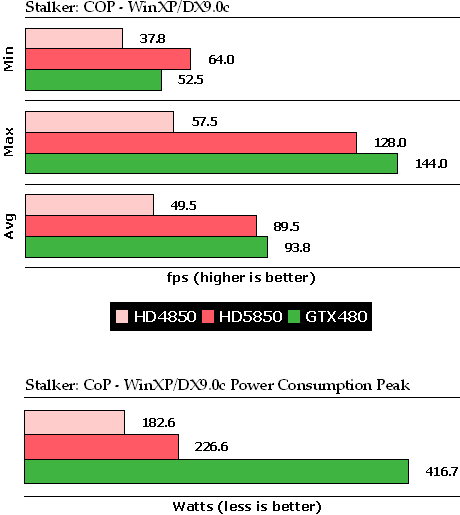

Dirt 2
The HD4850 runs without AA and high settings; the HD5850/GTX480 run with AA 4x and ultra settings where possible. Resolution as usual is 1080p. We have no settings for DX9 or DX10, but as you can see, the performance in Windows 7 drops, but so does power-consumption.
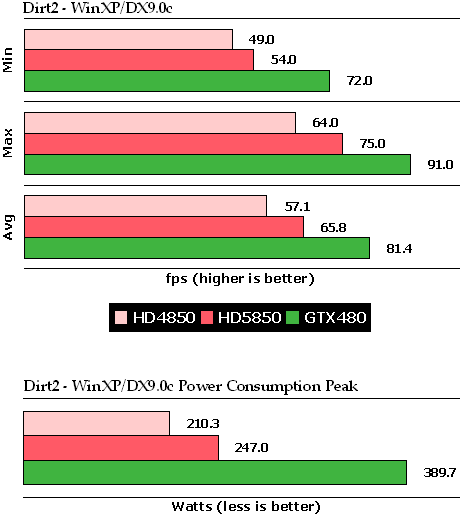

Company of Heroes
This is an older game with DX10 support, but enabling it does nothing but considerably slow it down. In the benchmark you can't see any graphics improvements. As usual resolution is 1080p, HD4850 runs with AA 4x and high settings, whereas HD5850/GTX480 runs with AA 8x and ultra settings where possible. In Windows 7 power consumption goes down considerably, but so does performance.
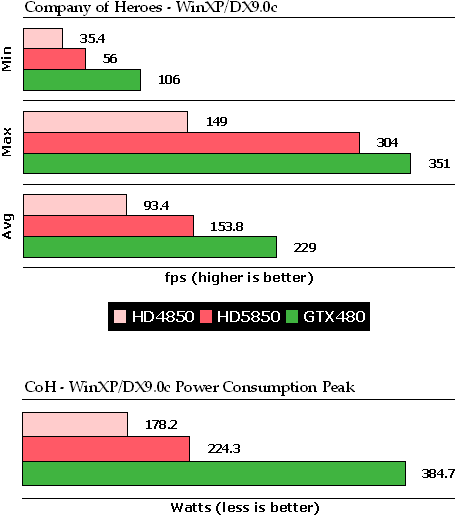
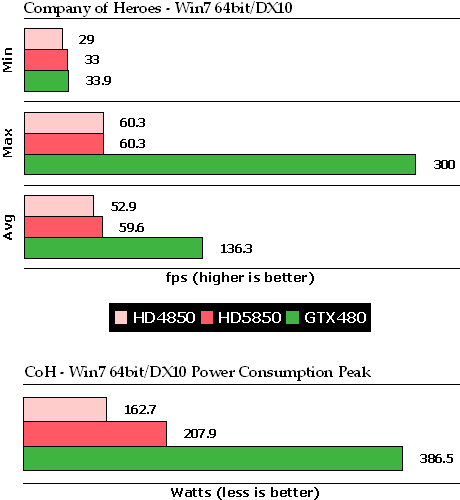
Spaceforce: Rogue Universe
This is a rather old game from 2007, with only DX9.0c support but one of the first with HDR support. It's the only game which has higher power-consumption in Windows 7 with ATI cards, but still lower performance. All cards run with 1080p, 8x AA, 8x AF and all effects set to high.

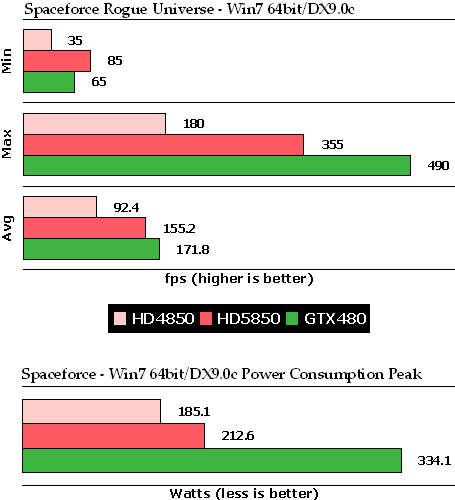
Lost Planet
This was one of the first games with DX10 support. Sadly with the ATI cards, the DX10 benchmarks fails to run with an odd error. So we had no choice to run the test with DX9 under Windows 7 with ATI’s cards. The GTX480 did not have that problem, so we could run it in DX10 mode, but as expected the performance slowed down considerably, so it can't be compared against ATI here. In Windows XP we could set the resolution for the HD4850 to 720p and with the HD5850/GTX480 to 1080p. All cards are set to AA x4, AF x8 and all other settings as high as possible. In Windows 7 the bench did not let us choose 1080p, the maximum we could set was 1600x1200, and the rest of the settings remained the same. The fps remained quite the same on the ATI cards, but they had to render 153.6k Pixel less.
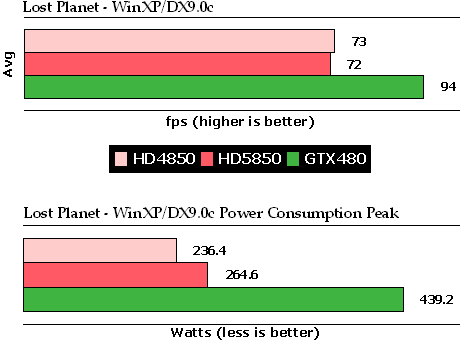
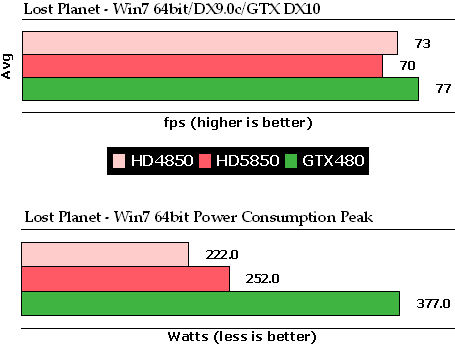
Desktop Power Consumption
Of course also normal power consumption is interesting. In idle mode the GTX480 clocks down to an insanely low 50/67.5/101MHz, but the power consumption is still much higher than on ATI's HD5850. Using a second display, which is quite standard in working environments, results with over 200W in idle for the GTX480. We must admit this is very high, as the HD4850 consumes this much while running games. MSI’s HD4850 does exceptionally well with two displays because it's custom PCB is able to beat even the HD5850. With only one display the MSI HD4850 does use more power, but it fares quite well, because it does not downclock the GPU.
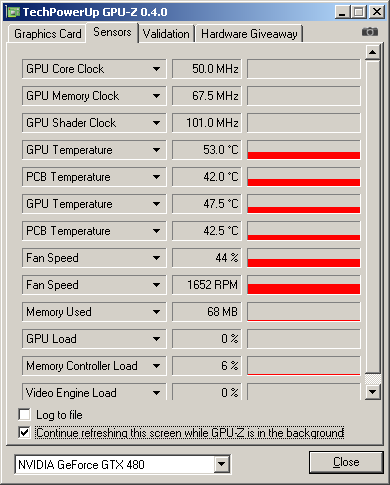
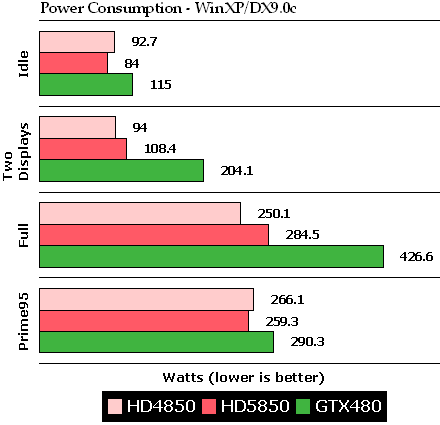
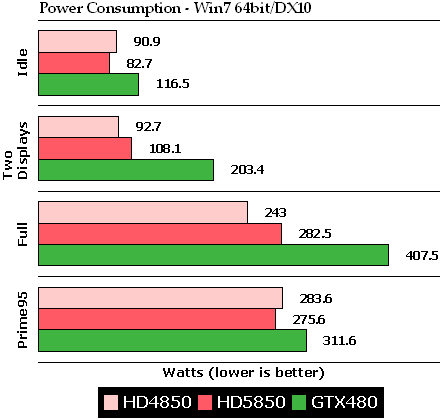
Conclusion
As expected the GTX480 sucks power like there is no tomorrow. At standard settings even an HD5850 gives plenty of FPS but unfortunately, we can't compare higher and better AA settings. The GTX480 was not planned as a run of the mill graphics card. It's the most complex GPU ever and it has a lot of GPGPU potential, but sadly it was heavily delayed and entered the market quite late. With The tessellation on the card will have some advantages, especially in upcoming titles, but until we see games that fully utilize this feature, AMD has more than enough time to improve its drivers or even come out with new cards.
Here we have a summary of all benches and how the HD5850 and GTX480 perform per Watt and per Euro. We have not included the HD4850 which has by far the best price/performance rating, but ran either with lower settings or lower resolution.
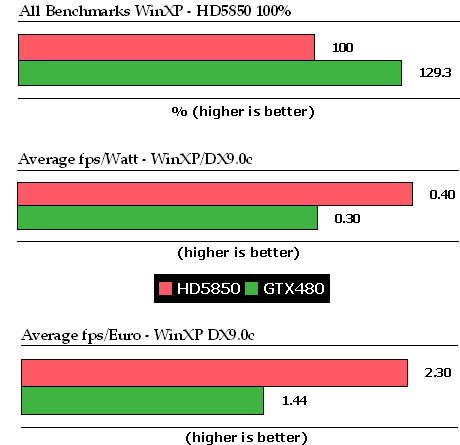

As usual in the high-end segment - the better the performance, the worse the price to performance ratio. The cheapest HD5850 is available at €254,90 while the cheapeset GTX480 will cost you €477,89. Of course you won't get twice the performance but at least 2/3 more power-consumption and very bad idle-power-consumption. While some might not care for power-consumption at all, an significant and still increasing number of users finds this one of the important criteria. Also the GTX480 is not that fast as we would have hoped and for nearly the same price you can get either two HD5850s or a HD5970 with much more performance and roughly the same power consumption as any GTX480.
Most interesting thing is that power-consumption in Windows XP is higher, but so is performance, at least when you do not consider DX10/DX10.1/DX11. Of course, due to obvious limitations, nobody is going to run DirectX 11 cards in XP. For some reason most game developers are unable to deliver 64-bit code which is quite easy to do, so the WOW32 system of any 64-bit Windows does have an impact on performance. While Microsoft is promoting 64bit OS it would make sense for gamers to use still a 32bit OS. If eye-candy is not that important to you, running a game in DX9 may offer a better experience especially when higher effect settings or higher Anti-Aliasing modes can be used.
